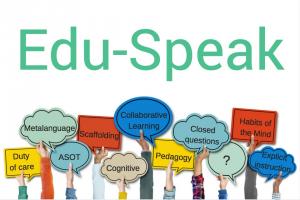
Do you sometimes hear words used at school, but wonder what they really mean?
This is a list of academic words and acronyms that you may hear used by teachers, to describe teaching and learning.
We will continue to grow our list, so feel free to contact us with a word you believe should be on Edu-Speak.
ASOT: is an acronym used to describe Marzano’s The Art and Science of Teaching. It is a teaching and learning framework, widely used by educators to plan effective instruction.
Closed questions: require only a one word answer such as 'yes' or 'no'. For example: Is that the right place for the full stop?
Cognitive: thinking processes such as understanding and problem solving. For example, cognitive development describes a child’s developmental stage and their level of thinking skills.
Collaborative learning: involves groups of learners working together to collectively solve problems, discuss and create. For example: MyPLC is a professional learning community for teacher aides to generate and share ideas and solve problems.
Duty of care: (in education) is to take all reasonable precaution to ensure the safety and well-being of students. For example: On playground duty you stay vigilant, observing what is going on.
Explicit instruction: a teaching strategy that provides students clear steps, examples and guidance. For example, the teacher aide assists students to identify verbs in a sentence by providing them with clear, sequenced information and practice until students can do the task independently.
Formative assessment: is done during the learning process to identify how and what students are learning and what the teacher needs to do next. For example: The teacher aide has been instructed to ask each student to weigh ingredients, to monitor and record their understanding of grams, milligrams and using a scale.
Habits of the Mind: Art Costa developed a set of 16 problem solving skills students can learn to become effective members of society. Many schools have incorporated these habits into their teaching and learning.
Metacognition: thinking about thinking. For example, the teacher aide helps the student to identify and name the strategies needed to work out a math problem, based on what they already know and still need to learn.
Metalanguage: language used to talk about language. For example, when teaching about grammatical features, the teacher aide uses metalanguage when using words such as verb, adjective and present tense.
Multiple Intelligences: Howard Gardner identified eight different intelligences. For example, a teacher aide has been shown different ways to help students learn, and uses a variety of learning experiences such as movement, pictures and discussion, when practicing number facts.
Open questions: require more than a one word answer and often begin with words such as How, What, and Why. For example: The teacher aide asks: Why is the decimal point in the wrong place?
Paraprofessional: (in education) assist teachers and have many titles such as teacher aide, education aide, classroom assistant.
Pedagogy: the practice of teaching and learning. For example: Pedagogical Framework refers to the identified teaching and learning processes that ensure the best outcomes for students. This is a whole school approach that includes the teaching and learning practices taught to the teacher aide.
Professional learning: is where educators reflect on their practice, are actively involved in learning, individually, and with others, to improve the outcome for students. Australian Teacher Aide is a professional learning community for teacher aides.
Scaffolding: is the support given to a student, based on their learning needs, with the aim to develop independent learners. For example, at the beginning of a cooking session with young students, the teacher aide models how to use knives safely.
Summative assessment: measures a student’s knowledge and understanding at the end of a unit using a benchmark. For example, to pass an exam students need 60% accuracy. Teacher aides assist teachers to collect summative data. For example, a teacher aide tests a list of spelling words and records this for the teacher.